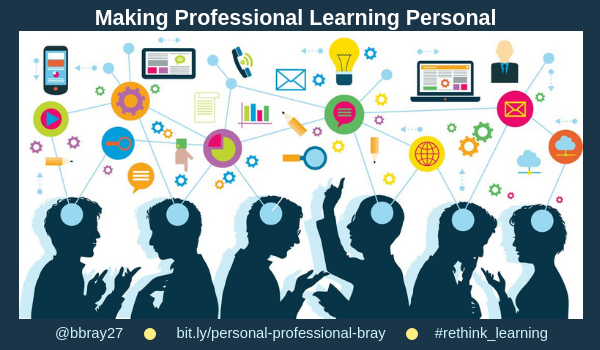
Unfortunately, too many teachers are leaving the profession because they may not be getting the support they need to do the job they are asked to do and even love to do. Now is the time to reverse the trend of teacher burnout. This can happen by improving a teacher’s professional learning by making it personal.
Every class, every teacher, and every student is unique so each situation could bring up questions, opportunities, and even confusion. Teachers may find that they will be learning something new more often than not. Teachers are a valuable element in the classroom and mean so much to each student. They need to be valued and appreciated.
Teachers can be partners in learning with students. To do this effectively, teachers need to determine their purpose for professional learning that defines the learning goals specific to the learning outcomes. Then they can identify instructional practices needed to implement so learners meet those learning outcomes. “One size fits all” professional development will not meet each teacher’s purpose and plan. Every teacher will need a plan with specific learning goals to personalize their own professional learning.
Learning Forward [www.learningforward.org] created a workbook for states, districts, and schools: Professional Learning Plans as the navigation system for the comprehensive professional learning system as the engine that powers educator learning. A program of professional learning is “a set of purposeful, planned actions and the support system necessary to achieve the identified goals.” Professional learning plans focus on the specific content, learning designs, implementation support, and evaluation of professional learning. The comprehensive professional learning system establishes the overall infrastructure and operations that support effective professional learning. The workbook provides teachers, schools, and districts the tools, resources, examples and models that will assist them in developing whole system professional learning plans and personal professional learning plans.
Some key questions to drive the development of your plan:
- What results do we seek for our students?
- What teacher practices contribute to those results?
- What must change in order to achieve those results?
The goal of professional learning should be stated in terms of student outcomes. Changes in educator knowledge, skills, dispositions, and practice are the means to changes in learning. Student and teacher goals are written in the SMART format increase the strength and clarity of the goals. Working SMARTER, not harder: SMART goals keep key objectives in focus as follows:
SMART Goals
S = Specific
M = Measurable
A = Attainable
R = Results-based
T = Time-bound
Consider this question: What student outcomes do you want to see that can be transformative?
Teachers need collaborative time to review and analyze student data. There are schools that are scheduling time once, twice, and, in some cases, daily, where teachers meet to plan together. Teachers usually work alone and have been isolated behind closed classroom doors for too long. When teachers have the time to work together, they can review how their students are learning, what they are learning, and any challenges. They can use SMART goals to develop learning objectives. For example, if teachers determine that 42% of their high school students do not understand linear equations, they can develop a learning goal and activity that targets these learners.
Example SMART Goal
42% of the high school learners will have resources and opportunities for a small group, one-to-one instruction, and ongoing peer support to increase their knowledge and skills around linear equations.
Teachers only know what they know or were taught. Some may follow a pacing guide and use the existing curriculum for the whole class even though we now know it doesn’t work for all learners. A teacher who is trying to “cover” the curriculum based on the pacing guide will never meet the needs of those students who are falling behind.
Instead of trying to “cover” the curriculum,
why don’t we try to “uncover” the learning?
When teachers start putting together SMART goals around learning outcomes based on data, they can go several steps further to determine how each of the 42% learners learn best along with any challenges they might have. There tends to be several students in a class that stand out with unique characteristics. Teachers may find out that more than one student may have trouble understanding math symbols where others have issues figuring out what the problems are stating. When you know specific issues that are challenges for your students, you can pull together strategies to target those challenges. This is where the Personal Professional Learning Plan comes in for each teacher.
Sample Personal Professional Learning Plan
(adapted from source: http://www.esclakeeriewest.org/files/Sample-Goals.pdf)
- State the Action you will take
- Describe an Area of Focus for the Learning
- Include the Rationale
- Add the Activities
| State Action | Describe Focus | Include Rationale | Add Activities |
| Improve | Teaching Skills | Assist at-risk students | Stay current with new practices |
| Develop | Proficiency in technology tools | Support instruction | Identify specific tools and resources |
The activities need to be personal for each teacher. That is where teachers can take control of their own learning. If a teacher wants to improve their teaching skills to assist at-risk students, they can use alternative learning opportunities to support them with their research. Traditional professional development (PD) usually doesn’t allow time for personalized support and attention. Some questions teachers have asked about PD:
- How do I stay current with new practices if I sit in a lecture that does not support my learning goal?
- How do I find specific resources around Algebra if PD that day is on classroom management?
- Why can’t I have time to do my own research or work with my colleagues around issues during the school day?
Teachers can get support by building their Personal Learning Network (PLN) in their school, district, community, and in social media. There are multiple learning opportunities outside of traditional professional development. This is where “personal” expand professional learning with opportunities that include:
- Common Planning Time

- Unconferences
- Edcamps
- Using Social Media
- Twitter chats
- Facebook pages
- Google+ Communities
- Linkedin Groups
- Instagram and Pinterest collections
Common Planning Time
Common planning time is different than “teacher preparation time” or “prep periods,” which are periods of time during the school day when teachers, typically working on their own, can plan and prepare for their classes, meet with students, or grade assignments. Common planning time is an evolution of the traditional preparation period to time that encourages more frequent and purposeful collaboration among educators. Its primary purpose is to bring teachers together to learn from one another and collaborate on projects that will lead to improvements in classroom culture, building positive relationships, lesson quality, instructional effectiveness, and student achievement.
Unconferences and Edcamps
An unconference is a conference organized, structured and led by the people attending it. Instead of passive listening, all attendees and organizers are encouraged to become participants, with discussion leaders providing moderation and structure for attendees.
Unconferences are founded upon The Law of Two Feet, which states that:
If during the course of the gathering, any person finds themselves in a situation where they are neither learning nor contributing, they must use their two feet and go to some more productive place.
An Edcamp is a user-generated conference – commonly referred to as an “unconference“. Edcamps are designed to provide participant-driven professional development for K-12 educators. In both cases, instead of one person standing in front of the room talking for an hour, people are encouraged to have discussions and hands-on sessions. All of the space and time is reserved for the things people want to talk about.
Twitter Chat
A Twitter or Tweet Chat is a planned “chat” on Twitter that organizes a group of people with similar interests in a particular subject matter. The host of the chat is the person that arranges and promotes it to their followers by picking a regularly scheduled time for the chat to happen. Teachers that are looking for specific resources can find them fast. Sign up with your own handle and find hashtags to follow like #edchat, #edtechchat, #tlap, and #plearnchat.
#rethink_learning is my Twitter chat that I (Barbara Bray @bbray27) co-host with Shelly Vohra @raspberryberet3 every other Monday at 7pm ET, 4pm PT. Join us!
_____
These are just a few strategies that teachers can use to take control of their own learning. Learning is personal and teachers are learners too. Check out what Vicki Davis wrote about 12 Choices to Help You Step Back from Burnout if you find yourself feeling a little blue.
Learning Forward. Professional Learning Plans. http://learningforward.org/docs/default-source/commoncore/professional-learning-plans.pdf
This post was adapted from my article that was first published in OnCUE Spring 2015 Vol 37 No 1 p. 23 and 26
****
For all of the Rethinking Learning podcasts with Barbara Bray, click on the podcast tab at the top, the logo below, or go to https://barbarabray.net/podcasts/
Go to this page for resources, questions, and more information about Barbara’s new book, Define Your WHY.





[…] Read the post here… […]